

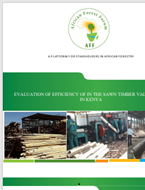
Evaluation of Efficiency of the Sawn Timber Value Chain in Kenya
The study team wishes to sincerely thank all the persons and institutions who supported
the conceptualization, field survey, and the preparation of this report. We thank the African
Forest Forum ...






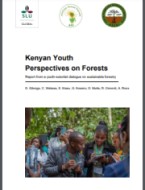
Kenyan Youth Perspectives on Forests: Report from a youth-scientist dialogue on sustainable forestry
This report presents proceedings of “AfricanYouth4Forests” project workshop held in Voi, Taita Taveta county, Kenya from 7 to 9 November 2022. The workshop was jointly organised by African Forest F...

REDD+ processes in Francophone Africa : case studies on conditions and determinants for successful implementation
La déforestation et la dégradation des forêts provoquent actuellement un déclin rapide du couvert forestier sur le continent africain. Entre 2010 et 2020, l’Afrique a enregistré un taux annuel de p...

Strengthening capacity among African forestry stakeholders for implementing REDD+ in Francophone Africa
Le Cadre de Varsovie adopté lors de la COP19 en 2013 fixe les lignes directrices de REED+. Le processus REDD+ comprend quatre (4) composantes qui doivent être toutes intégralement réalisées à savoi...
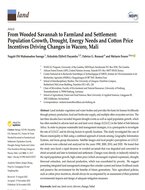
From Wooded Savannah to Farmland and Settlement: Population Growth, Drought, Energy Needs and Cotton Price Incentives Driving Changes in Wacoro, Mali
Land includes vegetation and water bodies and provides the basis for human livelihoods through primary production, food and freshwater supply, and multiple other ecosystem services. The
last three...
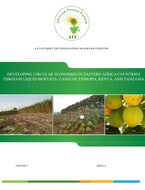
Developing circular economy in Eastern Africa through liquid biofuels: cases of Ethiopia, Kenya and Tanzania
The African Forest Forum (AFF) has undertaken studies in four African sub-regions to assess the potential of selected African countries to produce and use of liquid biofuels as a strategy for devel...
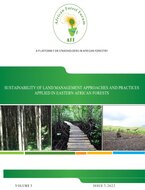
Sustainability of land management approaches and practices applied in Eastern African forests
The African Forest Forum (AFF) has implemented a project on “Strengthening management and use of forest ecosystems for sustainable development in Africa”. The project aimed to sustainably
manage f...
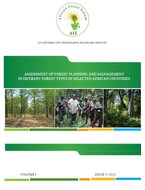
Assessment of forest planning and management in different forest types in selected African Countries
This study is part of a project on “Strengthening management and use of forest ecosystems for sustainable development in Africa”, which is funded by the Swedish International Development Cooperatio...
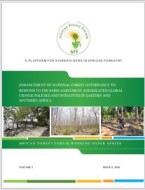
Enhancement of national forest governance to respond to the Paris Agreement and related global climate change policies and initiatives in Eastern and Southern Africa
Since climate change is one of the greatest threats to life on earth, it has become imperative that international forest and climate change dedicated instruments and cross-cutting issues instrument...
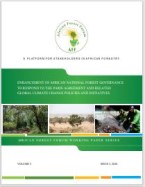
Enhancement of African national forest governance to respond to the Paris Agreement and related global climate change policies and initiatives
This sought to generate information and knowledge on climate change issues, to support actors in the forestry sector to formulate appropriate forest policies, programs, plans and activities that ha...
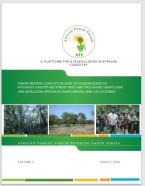
Strengthening capacity of forestry stakeholders to integrate and uptake forest and tree-based climate change adaptation and mitigation options in francophone African countries
Forests and trees provide huge opportunities for African countries to respond to their post-2020 climate change mitigation and adaptation commitments. The contribution of forests and/or trees to mi...
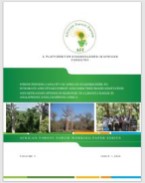
Strengthening capacity of African stakeholders to integrate and uptake forest and farm tree-based adaptation and mitigation options in response to climate change in Anglophone and Lusophone Africa
The vulnerability of rural households to climate change in Africa is caused by exposure to climate variability and extreme weather events and by a combination of social, economic and environmental ...
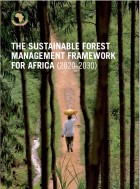
The Sustainable Forest Management Framework for Africa (2020-2030)
Extending over 624 million hectares (ha), covering 20.6 percent of the continent’s land area and representing 15.6 percent of the world’s forest cover, Africa’s forests have a unique role in contri...
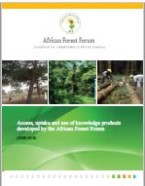
Access, uptake and use of knowledge products developed by the African Forest Forum
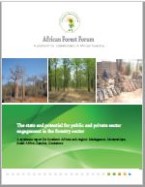
The state and potential for public and private sector engagement in the forestry sector

The Future of Food: Domestication and Commercialization of Indigenous Food Crops in Africa over the Third Decade (2012–2021)
This paper follows the transition from ethnobotany to a deeper scientific understanding of the food and medicinal properties of African agroforestry tree products as inputs into the start of domest...
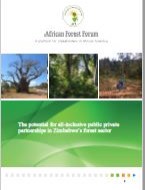
The potential for all-inclusive public private partnerships in Zimbabwe’s forest sector

Public and private sector development in forest products industry of South Africa
South Africa is faced with persistently high levels of poverty and unemployment. Forestry being a rurally based activity is ideally placed to contribute towards wealth generation and job creation i...
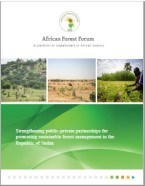
Strengthening public-private partnerships for promoting sustainable forest management in the Republic of Sudan

Public-private-partnerships in the forest sector and sustainable livelihood development in Nigeria


La filière bois en côte d’Ivoire: productions primaire et secondaire, relation entre les acteurs, tendance future et contribution à l’économie nationale et aux moyens de subsistance des populations
La présente étude a été conduite dans le cadre de deux projets de African Forest Forum (AFF) intitulés « Renforcement de la gestion durable des forêts en Afrique » et « Forêts d'Afrique, les Popula...

Partenariat public – privé dans le secteur forestier au Burkina Faso
Le Burkina Faso est un pays dont l’économie est basée, entre autres, sur le secteur primaire qui contribue en moyenne pour environ 30,90% au PIB national. Au cours de ces dernières décennies, cette...
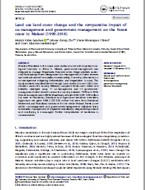
Land use land cover change and the comparative impact of co-management and governmentmanagement on the forest cover in Malawi (1999-2018)
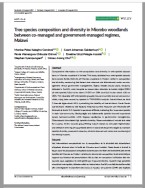
Tree species composition and diversity in Miombo woodlands between co-managed and government-managed regimes, Malawi
Comparative information on the composition and diversity in tree species associations in Miombo woodland is limited. This study assessed how tree species associations across forest reserves of Miom...

Partenariat public – privé dans le secteur forestier au Niger
Les forêts et les terres boisées soutiennent directement et indirectement les économies des pays sahéliens comme le Niger dans le développement des stratégies d’adaptation au changement climatique ...
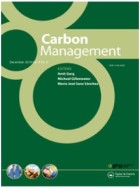
Aboveground and belowground tree biomass and carbon stocks in the miombo woodlands of the Copperbelt in Zambia
Globally, belowground biomass (BGB) accounts for 20–26% of total biomass, and as such it is an important carbon (C) pool for many vegetation types. However, large uncertainty exists for belowground...

Sustainable Business Models for Informal Charcoal Producers in Kenya
The sustainable business model (SBM) concept requires enterprises to integrate sustainability aspects in their planning and operations. Although 60% of the global working population make their livi...

AFF 10th Year Anniversary Celebrations Report
The 10th Anniversary of the African Forest Forum (AFF) was celebrated on 22 May 2019, at the Amani Gardens, Karura Forest Service grounds in Nairobi Kenya. The celebration of this important anniver...

Trans-boundary forest resources in West and Central Africa
This report presents the results of a study carried out in 2017 through visits to sampled West and Central African countries, namely: Niger, Sierra Leone, the Democratic Republic of Congo and Camer...
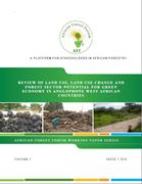
Review of land use, land use change and forest sector potential for green economy in Anglophone West African countries
Contemporary development trajectories over the years have continued to advance human well-being through phenomenal growth and wealth, never witnessed before in human history. With these advances ha...

Public-private-partnerships in the forest sector in Africa: Country Report for Uganda
Forest resources are of prime importance to the people and economy of Uganda owing to the range of ecological, economic, social and cultural products and services they provide for a multitude of st...
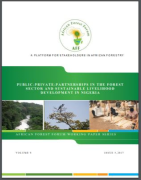
Public-private-partnerships in the forest sector and sustainable livelihood development in Nigeria
Public private partnership as a concept has gained ground over the last few decades as a virile approach to delivering goods and services. It is a contractual agreement between a public agency and ...
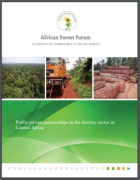
Public-Private Partnerships (PPP) in the Forestry Sector in Central Africa
The African Forest Forum (AFF) commissioned this study in four of the ten countries in Central Africa (Cameroon, Democratic Republic of Congo, Gabon and the Republic of Congo) as part of its activi...
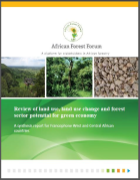
Review of land use, land use change and forest sector potential for green economy in Francophone West and Central African countries
This study aimed to assess the green economy potential in the forest sector. It identified and analysed key elements within the forest sector that contribute to green economy, as well as the variou...
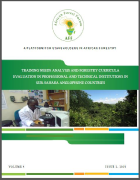
Training needs analysis and forestry curricula evaluation in professional and technical institutions in sub-Sahara Anglophone countries
Current training needs and emerging trends in the forestry sector have prompted a number of forestry educational institutions to review their traditional curricula in order to produce well equipped...
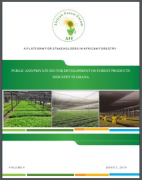
Public and private sector development on forest products industry in Ghana
This study was commissioned by the African Forest Forum to analyze the nature and trends in primary and secondary forest production in Ghana with emphasis on public and private sector contribution ...
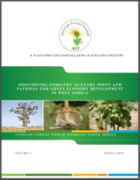
Positioning forestry as an entry point and pathway for green economy development in West Africa: African Forest Forum
This report presents the harmonized and expanded results of studies carried out in 2016 by two teams of researchers on the potential of forests for green economy development in West Africa: the Ang...

Potential for private sector development in Africa. A synthesis report for Eastern African countries of Kenya, Tanzania, Rwanda and Ethiopia
The primary production in Eastern Africa takes place in public natural forests, plantations, farm forests, community forests and private forests. These forests, for various reasons, are experiencin...

Shifting cultivation maintains but its conversion to mono-cropping decreases soil carbon and nitrogen stocks compared to natural forest in Western Ethiopia
Aims This study was conducted to assess the effects of shifting cultivation and its conversion to mono-cropping on soil organic carbon (SOC) and total nitrogen (STN). Methods We compared soil pH, t...
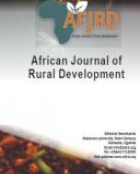
Africa Journal of Rural Development (AFJRD) .Some key issues in Africa’s Forestry
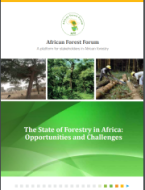
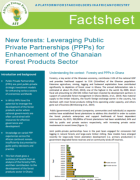
New forests: Leveraging Public Private Partnerships (PPPs) for Enhancement of the Ghanaian Forest Products Sector
Understanding the context: Forestry and PPPs in Ghana
Forestry, a key sector of the Ghanaian economy, contributes 2-6% of the national GDP and provides livelihood support to 15%...

Strengthen Public Private Partnerships for Advancement of the Ghanaian Forest Products Sector
Forest sector contribution to Ghana’s GDP declined from 6% in the 1990s to 4% in 2014 as exports of timber and other forest products decreased from 11 to 1.3% of merchandize trade flows (Birinkoran...
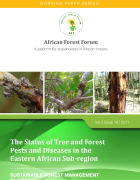
The Status of Tree and Forest Pests and Diseases in the Eastern African Sub-region
In this study of tree and forest pests and diseases conducted in 2015 for the Eastern African sub-region, Sudan, Ethiopia, Kenya and Rwanda were selected for detailed analysis to provide an overvie...

Situational analysis of commercial and community tree planting in Southern Africa
The review is part of the African Forest Forum (AFF) project on Sustainable Forest Management (SFM) in Africa supported by the Swedish International Development Agency (SIDA). It addresses SFM in t...
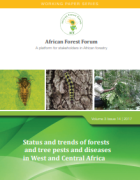
Status and trends of forests and tree pests and diseases in West and Central Africa
Forests and trees constitute a very important component of natural resources for countries in West and Central (W/C) Africa. The region also has one of the highest rates of deforestation and forest...

Interactions between native tree species and environmental variables along forest edge-interior gradient in fragmented forest patches of Taita Hills, Kenya
Comparative investigations were undertaken in five forest fragments (Chawia, Fururu, Mbololo, Ngangao and Vuria) of varying sizes in Taita Hills, Kenya to examine the effects of forest edge on soil...

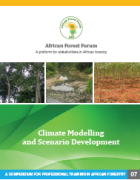

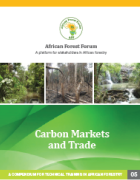




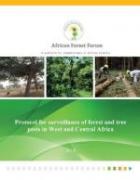
Protocol for surveillance of forest and tree pests in West and Central Africa
This draft protocol has been prepared to guide regional and national
phytosanitary practitioners in West and Central Africa to develop and
implement forest and tree pest and disease surveillanc...

Overview of restoration and management practices in the degraded landscapes of the Sahelian and dryland forests and woodlands of East and southern Africa. Southern Forests: a Journal of Forest Science, Vol. 79, 2017. 10.2989/20702620.2016.1255419
The highest deforestation and forest degradation rates in Africa occur in the dry forests and woodlands where pressure for land is increasing, poverty is rampant, livelihood options are few and cli...

The relative importance of climatic gradient versus human disturbance in determining population structure of Afzelia africana in the Republic of Benin. Southern Forests: a Journal of Forest Science, Vol. 79, 2017. DOI: 10.2989/20702620.2016.1255406
The study aimed to investigate the relative significance of effects of climatic variability and human disturbance on the population structure of the threatened species Afzelia africana Sm. ex Pers....

Growing common plantation tree species in Kenya for sale of carbon and wood supply: what is the best bet?
The introduction of carbon finance as an incentive in forestry farming has a potential of increasing the amount of carbon sequestered. However, this has created a daunting task among investors in f...

A review of carbon dynamics and assessment methods in the miombo woodlands. Southern Forests: a Journal of Forest Science, Vol. 79, 2017. DOI: 10.2989/20702620.2016.1277643
Provision of accurate carbon (C) measurements and analysis are critical components in quantification of C stocks. The objectives of this review were to (1) compile and synthesise current knowledge ...

The characteristics of financing arrangements for the production and marketing of shea (Vitellaria paradoxa) butter in Tamale in the Northern Region of Ghana. Southern Forests: a Journal of Forest Science, Vol. 79, 2017.DOI: 10.2989/20702620.2016.1255403
Shea (Vitellaria paradoxa) butter is an important internationally recognised economic commodity because of its food and medicinal potentials. However, access to finance for small-scale forest enter...

Socio-economic factors influencing marketing of non-timber forest products in tropical lowland rainforests of south-western Nigeria. Southern Forests: a Journal of Forest Science, Vol. 79, 2017. DOI: 10.2989/20702620.2016.1255411
A number of factors persist to constrain the non-timber forest products (NTFPs) market and, by extension, its potential to contribute meaningfully to livelihood development and poverty reduction ob...

Socio-economic factors influencing household dependence on forests and its implication for forest-based climate change interventions. Southern Forests: a Journal of Forest Science, Vol. 79, 2017. DOI: 10.2989/20702620.2016.1255420
In most African countries, forest-based climate change intervention initiatives such as nationally appropriate mitigation actions (NAMAs) and national adaptation programmes of action (NAPAs) a...
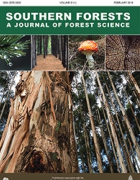
Restoration of degraded ecosystems in the Afromontane highlands of Ethiopia: comparison of plantations and natural regeneration. In Southern Forests: a Journal of Forest Science, Vol. 79, 2017. DOI: 10.2989/20702620.2016.1254917
The scale of deforestation in sub-Saharan Africa underscores the need for forest restoration. Information is scarce for evidence-based restoration options. Sown Senna didymobotrya, planted Fic...

Evaluation of the sustainability of participatory management of forest plantations: the case study of Wari-Maro Forest Reserve, Republic of Benin. In Southern Forests: a Journal of Forest Science, DOI: 10.2989/20702620.2016.1255409
This study assessed ecological and socio-economic impacts of a participatory forest management project in the Republic of Benin. The study focused on the Wari-Maro Forest Reserve and the Proj...

An assessment of the forest regeneration potential of the taungya system of farming in Oyo State, south-western Nigeria. In Southern Forests: a Journal of Forest Science, Vol. 79, 2017. DOI: 10.2989/20702620.2016.1255425Vol. 79, 2017.
Balancing forest regeneration and meeting food and fibre needs of Nigerias ever-increasing population challenges is imperative to her sustainable development. Two methods of artificial forest...

Forests, people and environment: some African perspectives. Southern Forests: a Journal of Forest Science, Vol. 79, 2017. DOI: 10.2989/20702620.2017.1295347
Forests in Africa support the livelihoods of millions of people through provision of timber and non-timber forest products, food and nutrition, energy and payment of environmental services. Ho...


Forestry and Resilience to Climate Change: A Synthesis on Application of Forest-Based Adaptation Strategies to Reduce Vulnerability Among Communities in Sub-Saharan Africa
Forests and trees outside forests play an important role on mitigation of climate change through sequestering of carbon from the atmosphere. However, little has been documented on the role of fores...

Growing common plantation tree species in Kenya for sale of carbon and wood supply: what is the best bet?. Southern Forests: a Journal of Forest Science, Vol. 79, 2017. DOI: 10.2989/20702620.2016.1274860
The introduction of carbon finance as an incentive in forestry farming has a potential of increasing the amount of carbon sequestered. However, this has created a daunting task among investors in f...
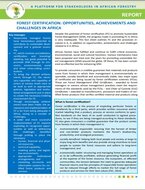
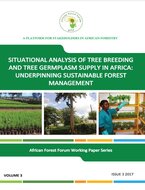

Forest diseases: regional inaction is a threat to sustainable forest management in Southern Africa
The highlights presented in this fact sheet on the current status of forest diseases in southern Africa are based on a review of literature and country visits to gather information and expert opini...

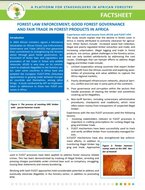
Forest law enforcement, good forest governance and fair trade in forest products in Africa
Introduction
In 2003 African ministers signed a Ministerial Declaration on African Forest Law Enforcement, Governance and Trade (AFLEG) that galvanized their commitment to strengthening the forest...

Forest pests in southern Africa: an emerging alarming situation
Introduction
The highlights presented in this fact sheet on the current status of forest pests in southern Africa are based on a review of literature and country visits to gather information and e...
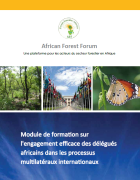
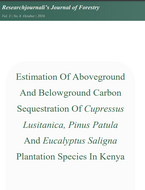
Estimation Of Aboveground And Belowground Carbon Sequestration Of Cupressus Lusitanica, Pinus Patula And Eucalyptus Saligna Plantation Species In Kenya
Carbon sequestration has become a crucial service forests provide for regulation and mitigation of climate change through reduction of greenhouse gas emissions. In Kenya, Cupressus lusitanica, Pinu...
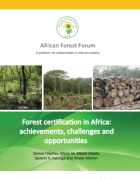
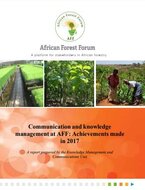
Communication and knowledge management at AFF: Achievements made in 2017
Forests and forestry continue to be very much profiled on the global agenda and their relevance to other sectors of national economies is increasingly been recognized and appreciated. This progress...
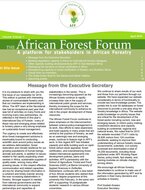
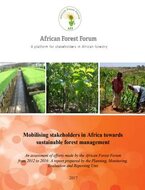
Mobilising stakeholders in Africa towards sustainable forest management: An assessment of efforts made by the African Forest Forum from 2012 to 2016
This report highlights some findings from evaluation activities that have been undertaken on projects implemented by the African Forest Forum (AFF). Specifically, the evaluations were undertaken wi...

Management and restoration practices in degraded landscapes of Southern Africa and requirements for up-scaling. In International Forestry Review Vol.17 (S3)
Summary
Southern African woodlands support the livelihoods of millions of both the rural and urban dwellers through the provision of non-wood products including supply of energy and agricultural e...
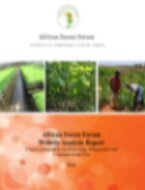
AFF Website Analysis Report
The African Forest Forum (AFF) website serves as a knowledge and information hub on African forestry for its members and stakeholders. It avails knowledge on priority issues that are critical for t...

Sustainable land management practices in the Sahel: review of practices, techniques and technologies for land restoration and strategy for up-scaling. In International Forestry Review Vol.17 (S3)
Land conversion and degradation in the Sahel have emerged as a primary concern. The process leading to land conversion is sometimes as a consequence of multiple economic, social, cultural and polit...
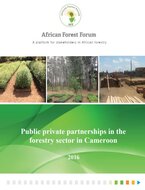
Private forestry sector in Cameroon: status and potential
Cameroon's land area covers about 46 million ha with 16.8 million ha as dense tropical forests and 29.8 million ha as degraded humid forests. The almost double proportion of degraded forests to den...

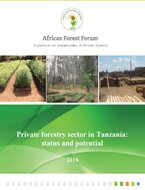
Private forestry sector in Tanzania: status and potential
In many African countries, the private sector in forestry is almost non-existent as an organized entity that one can dialogue with. This is also true in Tanzania, the country this study reports on,...
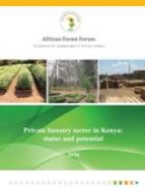
Private forestry sector in Kenya: status and potential
This study provides information to support catalysing the emergence of organized private sector in forestry in Kenya, through promotion of promising public private partnership (PPP) approaches for ...

Newsletter Vol 7 Issue 1 EN
Message from the Executive Secretary
I am pleased to share with you our AFF e-newsletter. Since our last newsletter, there have been several new and exciting stories to share with the African fore...

A brief overview of the capacities of public forest administrations in climate change work in the moist forests countries of Sub-Saharan Africa. In International Forestry Review Vol.17 (S3)
Summary
The work of Public Forest Administrations (PFAs) has evolved from forest management, to sustainable forest management, to management of forests and woodlands for ecosystem goods and servic...

A review of capacities of public forest administrations for interventions in climate change activities in the dry forest and woodland countries of Sub-Sahara Africa. In International Forestry Review Vol.17 (S3)
Summary
Public Forest Administrations (PFAs) have been transformed from the policing type agencies for forest protection and conservation into modern people-centred institutions applying partici...

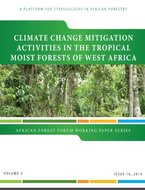
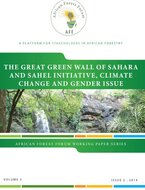

Strengthening African capacity to monitor and report on compliance to international processes related to forests and climate change. Working Paper Vol. 3(2)
The African continent remains the most vulnerable region in the world to the impact of climate change, mainly due to weak resilience and adaptive capacity. There is limited knowledge on the relatio...
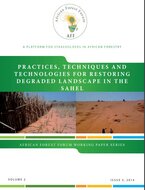

Management and restoration practices in degraded landscapes of Eastern Africa and requirements for up-scaling. In International Forestry Review Vol.17 (S3)
The paper reviews forest restoration and rehabilitation efforts as well as the contributing factors to up-scaling successful restoration practices in eastern Africa. It discusses the main forms of ...


Newsletter Vol 5 Issue 4 EN & FR
MESSAGE FROM THE EXECUTIVE SECRETARY
It is with great pleasure that the African Forest Forum brings you this special edition of our October 2015 newsletter. This newsletter has a strong focus on t...
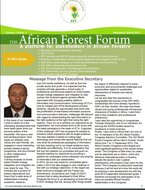
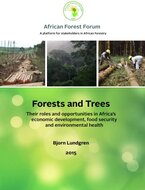
Pre-XIV World Forestry Congress Workshop Forests, People and Environment: Some Perspectives from Africa 4-5 September 2015 Durban, South Africa – Book of abstracts.
In Africa, nearly all issues in the forestry debate of today revolve, directly or indirectly, around deforestation and forest degradation. Although current information as reported by FAO indicates ...
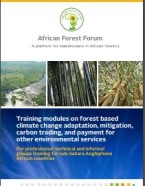

Biofuel initiatives in West Africa and the Sahel: potential for success. In International Forestry Review Vol.17 (S3)
Summary
Global warming has heightened the need to substitute fossil fuels with biomass-based energy sources. Some West African countries have recorded appreciable progress in this regard though wi...

Market potential of non-wood forest products in the Sahelian countries. In International Forestry Review Vol.17 (S3)
Summary
Non-wood forest products (NWFPs) are important sources of dietary supplement in all countries of the Sahel. The most valued forest products are gum Arabic (Acacia Senegal, Shea butter (Vit...
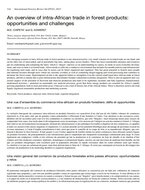
An overview of intra-African trade in forest products: opportunities and challenges. In International Forestry Review Vol.17 (S3)
Summary
The emerging scenario in intra-African trade in forest products is one characterised by very small volumes of recorded trade on one hand, and on the other one of unrecorded, and of potenti...

An overview of nationally appropriate mitigation actions (NAMAs) and national adaptation programmes of action (NAPAs) in Africa. In International Forestry Review Vol.17 (S3)
Summary
The global initiative to manage forests in response to climate change emanated from the seventh and thirteenth Conference of the Parties (COP 7 and 13) under the aegis of the United Nation...

Forestry-related input into relevant policies at the regional and global levels: an African perspective on climate change. In International Forestry Review Vol.17 (S3)
Summary
This paper describes regional forestry and forestry-related policies of the Sub-Saharan Region of Africa, with a view to reveal and discuss their influence on both regionional cooperation,...

Climate vulnerability of socio-economic systems in different forest types and coastal wetlands in Africa: a synthesis. In International Forestry Review Vol.17 (S3)
Summary
Forests, woodlands and coastal wetlands of Africa serve important ecological functions and provide goods and services that contribute significantly to livelihoods at local, national and gl...

Climate vulnerability of biophysical systems in different forest types and coastal wetlands in Africa: a synthesis. In International Forestry Review Vol.17 (S3)
Summary
This article synthesizes information on climate vulnerability of biophysical systems in forests, woodlands and coastal wetlands of Africa. Current knowledge indicates that forests and wood...
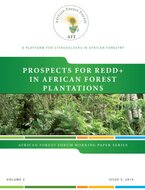
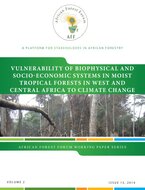
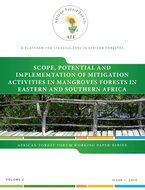
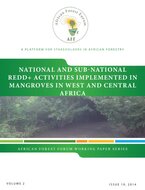

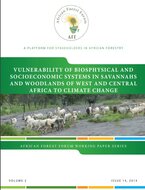


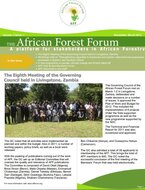


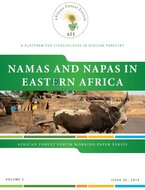
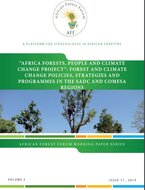
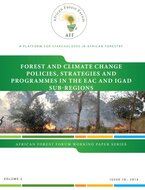
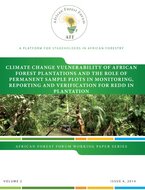
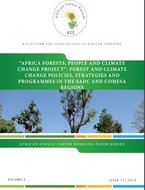

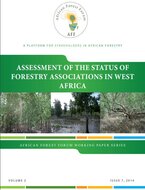
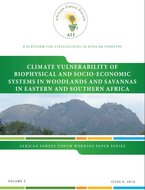


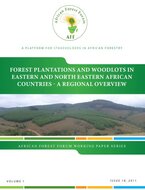
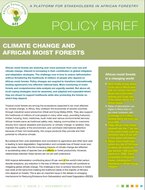
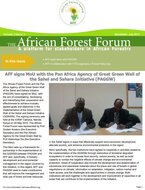
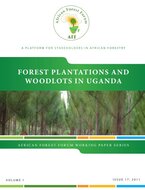


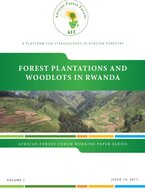



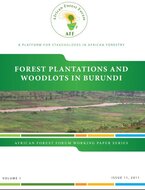



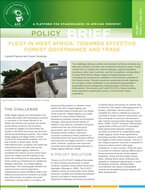
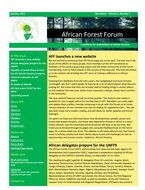




Swedish-African forest relations
In the first phase of the project Lessons learnt on Sustainable Forest Management in Africa (SFM I, 20022005) funded by Sida and carried out jointly by the African Forest Research Network (AFO...

African-Swedish collaboration programme on sustainable forest management:Final report on the planning phase of the project
This report contains the outcomes of the planning phase of a joint project between the African Forest Forum and the Royal Swedish Academy of Agriculture and Forestry. The project started in early 2...





